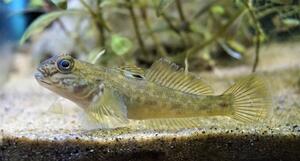Round Goby
Round Goby (Neogobius melanostomus)
Where did the round goby come from?
- The round goby comes from the Black & Caspian Seas in Europe.
- It was introduced into the U.S. via ballast water into the St. Clair River, near Detroit, MI in 1990.
- The round goby has not been found in Kansas.
What do round gobies look like?
- Round gobies are bottom-dwelling fish that perch on rocks and other substrate.
- They can grow to 10 inches as adults.
- Gobies have large heads, soft bodies, and dorsal fins lacking spines; they slightly resemble large tadpoles.
- The gobies' unique feature is their fused pelvic (bottom) fins, which form a suctorial disk that aids in anchoring the fish to the substrate.
- Young round gobies are a solid slate gray; larger individuals have blotches of black and brown over their bodies, and their dorsal fin may be tinged with green.
Why are round gobies a problem?
- The round goby can displace native fish from prime habitat and spawning areas.
- Round gobies eat the eggs and young of other fish species.
- Have a competitive advantage over other species because of the ability to survive in poor quality water.
How do round gobies spread?
- The round goby was first brought to North America in ballast water.
- They may be spread to other waters by aquatic users.
How do we control round gobies?
- Learn to identify the round goby.
- Always drain water from your boat, livewell, and bilge before leaving any water access.
- Always dispose of your unwanted bait on land or in the trash.
- Never dip your bait bucket into a lake or river if it has water in it from another waterbody.
- Never dump live fish from one waterbody into another.
What do I do if I find a round goby?
- Anglers are often the first to discover round gobies because these aggressive fish are commonly caught by hook and line. Your help to report new sightings and to prevent their spread is vital.
- Do not release the fish back into the water. If you catch a round goby, freeze it in a sealed plastic bag, note the date and location, and call the Emporia Research Office at (620) 342-0658 or email the Aquatic Nuisance Species Coordinator.








